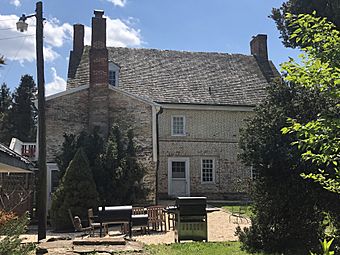Howard Lodge facts for kids
Quick facts for kids |
|
|
Howard Lodge
|
|
 |
|
| Location | 12301 Howard Lodge Road, near Sykesville, Maryland |
|---|---|
| Area | 15 acres (6.1 ha) |
| Built | c. 1750 |
| Architectural style | Georgian |
| NRHP reference No. | 12000845 |
| Added to NRHP | October 9, 2012 |
Howard Lodge is a very old and important house located in Howard County, Maryland. It was once the main building of a large farm. This house was built around 1750.
It was constructed by Edward Dorsey. His father, John Dorsey, also played a role in the family's history. Howard Lodge is one of the oldest farmhouses in the entire county.
Compared to other homes from that time, Howard Lodge is quite large. It is made of brick and stone and has two stories. The inside parts of the house are still in great condition. The property today covers about 15 acres. It also includes other old stone buildings from the early 1800s. Like many large farms of that time, the work at Howard Lodge was done by enslaved African Americans.
Contents
Discovering Howard Lodge
Howard Lodge is a special place. It helps us learn about life in Maryland long ago. The house shows us how people lived and worked centuries ago.
What is Howard Lodge?
Howard Lodge is known as a "plantation house." This means it was the main home on a very large farm. These farms often grew crops like tobacco or cotton.
The house itself is a great example of Georgian architecture. This style was popular in the 1700s. Georgian buildings often look very balanced and grand. They usually have a clear, symmetrical design.
A Look at Its History
The main house at Howard Lodge was built around the year 1750. Edward Dorsey was the person who had it built. He was a member of an important family in the area.
The property was a working farm for many years. It saw many changes throughout its long history. The stone outbuildings, built in the early 1800s, were likely used for farm work or storage.
Becoming a Historic Landmark
Because of its age and importance, Howard Lodge was recognized nationally. It was added to the National Register of Historic Places in 2012.
Being on this list means the property is considered very important to American history. It helps protect the house and land so future generations can learn from it.



